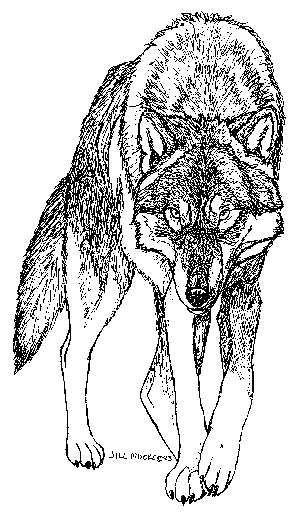
The USFWS decided at the end of August that the forest management plan presented by the US
Forest Service for the Tongass National Forest (Tongass) included enough protections for the
Alexander Archipelago wolf and the Queen Charlotte's goshawk that these species did not need
to be added to the Endangered Species List. A judge ruled that this decision was legal, and gave
environmentalists who disagree 90 days to respond.

The fight over management of the Tongass has been intense, with timber companies insisting they need to increase logging levels in order to keep employment levels up and remain financially viable. Others protest that this forest has already been intensively cut and at this point restrictions are needed to keep the integrity of the ecological systems in place.
The new plan includes some reserves where logging is banned and decreases logging from past levels. But David Person, a PhD candidate at the University of Alaska who has been studying the Alexander wolves is not convinced that the wolves are safe.
Although admitting that the wolves will not go extinct under the new plan, as the population on the mainland (about 40% of the whole population) is not under the pressure that the island populations are, he does think that the third of the population living on Prince of Whales Island could drop 25-35% over the next century.
According to Person there are currently about 900-1000 Alexander wolves in existence. They are distinctly different than their cousins in the interior of Alaska, and exist only on a few islands and in a pocket on the mainland. The main element needed to keep the population of wolves, is a decent level of sitka black-tailed deer. By logging and building logging roads, the forests are being altered in such a way that the deer can no longer survive. When the deer decrease, so do the wolves.
In another twist, as deer levels decrease, forcing wolf populations down, the subsistence hunters in the area will also suffer from the decrease. But they are likely to call for wolf control measures to be used to keep deer levels up, though the loss of habitat will be the guilty party to deer loss.
Some biologists argue that if the wolves are not in danger of extinction, there is not a real problem. They cite the small populations of wolves in Italy and Spain that have hung on for centuries despite intense persecution. But Person does not believe this is the optimal situation for wolves.
The reason Person fears for the wolves is that he believes the US Forest Service has a terrible track record of keeping their actions in line with the management plans as interpreted by most people. On paper the Tongass plan looks quite good, Person said, but he has experienced the USFS using loopholes and other methods to get around limitations contained in their own documents.
An example he cited occurred in an area called Honker Divide, a valley in the Tongass. This had been listed as exempt from logging in a USFS plan. The Honker Divide had always been defined by all parties as containing the land from ridge to ridge of the surrounding mountains. But when it came time to decide where to log, they redefined the Divide as "road to ridge," the road being in the valley. With the new definition they were able to go in and legally log part of the area. In the new Tongass plan there are no clear descriptions of boundaries, a common practice which allows them to do whatever they please, Person said.
Another problem Person has found with the USFS is that they divide management of projects into levels, one broad, one specific. When a citizen contacts them to discuss a problem with some aspect of a project they will refer the person back and forth, one representative saying the issue is too broad for the project level staff, and the other saying it is too specific for the plan level. In the mean time the problem is not being addressed.
Person and his associates have written a letter to the Forest Service describing where the new plan does not live up to the recommendations in the conservation assessment on which it was based.
Person said that he has learned about much more than wolves while working in the Tongass on his degree. Like it or not he will be intimately involved in what promises to be ongoing litigation as environmentalists request further decreases in logging and the timber industry requests the opposite. The timber interests have already said that if the wolf and goshawk are not going to be listed, surely logging levels can also be raised......
It is reprinted from the Summer 1997 Issue of WOLF! Magazine. This unique and comprehensive magazine is not supported by advertising, but by subscriptions. Please help keep this much needed resource alive!
 |